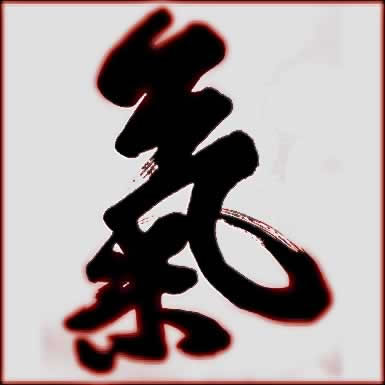
THE STUDY OF THE PAST TO ROLL TO THE FUTURE: INVESTIGATING THE HERITAGE OF ART, ENERGY, MEANING, MEMORY AND CONTEXT IN THE WRITINGS OF HSIEH HO, 6TH CENTURY CHINESE ART CRITIC.
It’s been said by one that “Energy is eternal delight.”
William Blake
As I keep working forward, I find myself, literally, in the going: back.
What I note is that learnings and inspirations continue to flower and re-present themselves—to what the heart first opened, so shall it renew in rediscovering a patterning that might be successively revealing itself. That is, there’s a moment when you might experience a mind-rending realization, an electrifying bounce of insight, a sudden and staggering exposure to beaut. It’s life-changing. It forever alters the way that you see things. You’re learning, but it’s a lightning strike of activation.
Change is immanent in all our lives but
there are patterns of discovery that are
overwhelmingly
unforgettable.
“I remember when…”
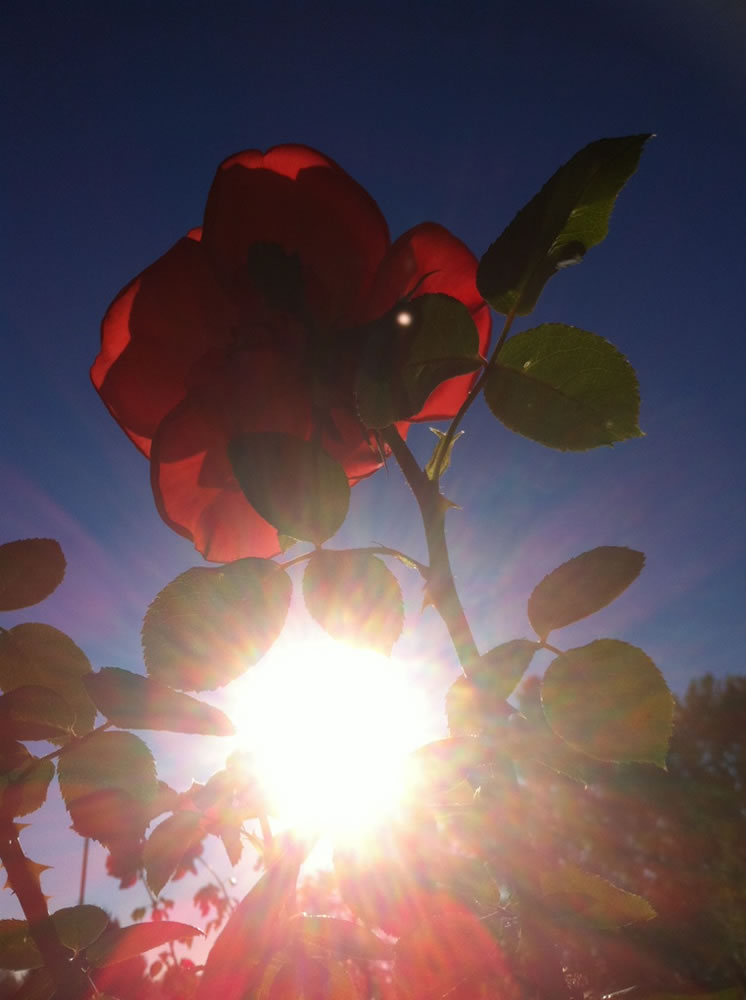
I find myself, as casual as that might sound, but that’s it: it’s the learning of finding yourself and the patterning of revelation.
This struck me, in just that manner:
“A man’s work is nothing but this slow trek to rediscover, through the detours of art , those two or three great and simple images in whose presence his heart first opened.”
Albert Camus
In my teaching calligraphy to the GIRVINists in our Seattle office, we walk back centuries in time to explore the hand-drawing of letterforms from hundreds and finally, thousands of years ago. I call it “breathing time,” since students are forced to step out of the present and move far into distant and antiquated times and minds to learn the why of alphabetic evolution.
In that going back, what happens is I see these patterns—points of learning that are still compelling today. Like energy—what is it about that person that’s so compelling, attractive or disjointing and repulsive? It’s their energy, more often than not. That intrinsic vibration, as a wave-pulse, the throb of sensation; it’s how we sense people, environments and their combinative intertwining. So to the notion of brand, spirituality and a mystical line of thinking about the vibe of brands, their brandspirit, there is this sense of energy.
When you think about your favorite brand, what kind of energy does it have, running through it, out to you? How would you describe that?
Personally, I look for that. When I’m working on a new brand, a new enterprise, I’m sensing and contemplating the vibe of it, which might be energizingly exciting and mobilizing, intense and fraught with a frantic demeanor, calming and serene, integrated and articulate or disjointedly disparate and broken.
It always comes down to the what of vibe.
Earlier in my career, decades back, I was exposed to the study of classical Chinese art theory and its applications to art, architecture and spiritual principles.
This was connected to studying calligraphy and painting.
Working with different masters, from China and Japan, I explored the context of Western approaches to illustration, type design and the treatment of the letterform.
The idea of capturing the spirit of the “thing”, is about literally reaching to spirit — the momentary and momentous essence of an object, as it is living and moving. And importantly, the breath of life that nourishes its vitality. Breath, in this context reaches to the heart of spirit. And that can be traced, etymologically, right to the essence of the word itself.
Go back:
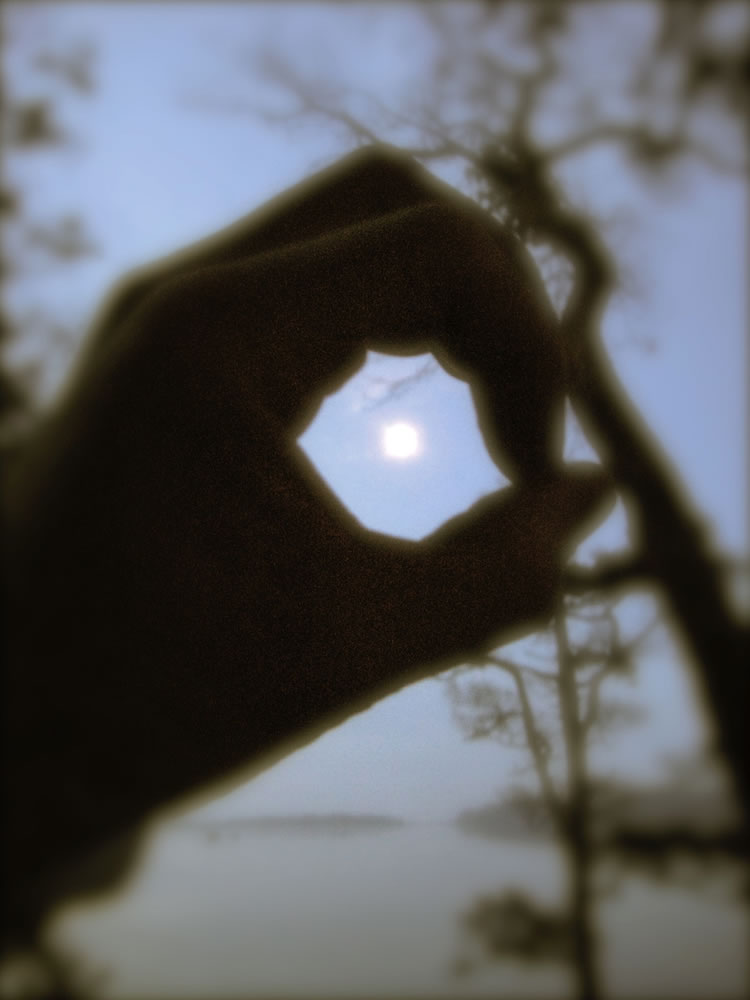
S P I R I T (n.)
c.1250, “animating or vital principle in man and animals,” from O.Fr. espirit, from L. spiritus “soul, courage, vigor, breath,” related to spirare “to breathe,” from PIE *(s)peis- “to blow” (cf. O.C.S. pisto “to play on the flute”). Original usage in Eng. mainly from passages in Vulgate, where the L. word translates Gk. pneuma and Heb. ruah. Distinction between “soul” and “spirit” (as “seat of emotions”) became current in Christian terminology (e.g. Gk. psykhe vs. pneuma, L. anima vs. spiritus) but “is without significance for earlier periods” [Buck]. L. spiritus, usually in classical L. “breath,” replaces animus in the sense “spirit” in the imperial period and appears in Christian writings as the usual equivalent of Gk. pneuma. Meaning “supernatural being” is attested from c.1300 (see ghost); that of “essential principle of something”.
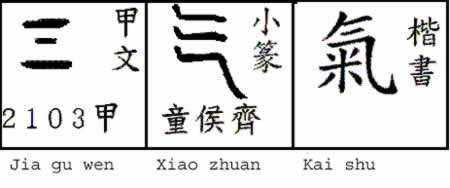
The essential character of ch’i is wrapped in the context of the calligraphic ideogram itself — as noted above — interpreted most memorably, at least for me, in the concept of the L-shaped stroke representing the “altar”, the four stroked treatment beneath speaking to the four elements, or the “rice grains” of the sacrifice — and above, the finishing strokes representing the vapor of the offering, to heaven.
And the commentary and exploration of this sixth century grouping of precepts is extensive, and ranges into centuries of study and notations of later interpretation.
Alexander C. Soper’s “The First Two Laws of Hsieh Ho:
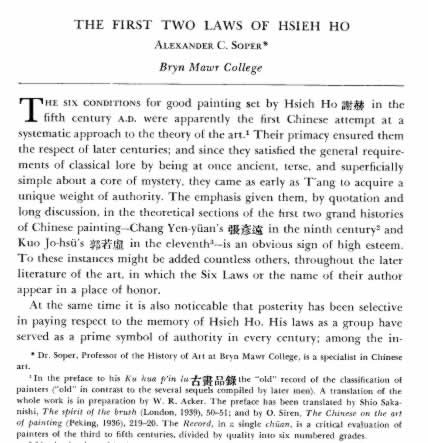
Fritz van Briessen’s “The way of the Brush”
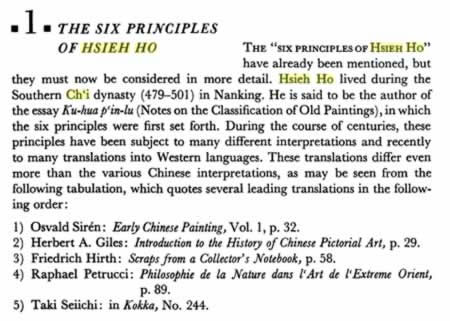
Or Clay Lancaster’s treatment, for the Journal of Aesthetics & Art Criticism:
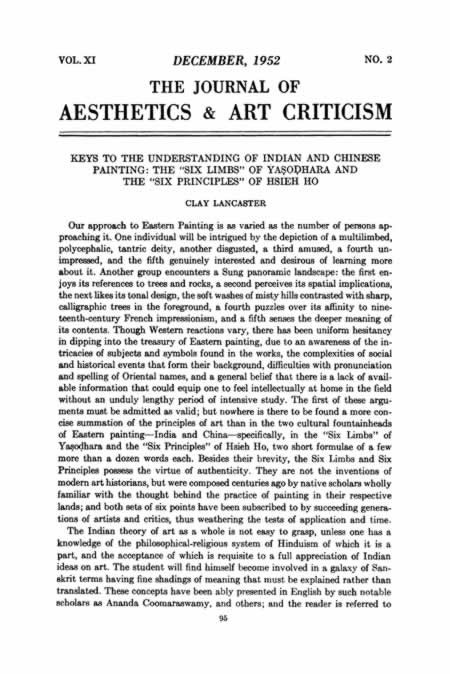
And there are dozens of others to be explored. But the point is about capturing, and illustrating — or literally, lustrating, the concept of the spirited energy of the object being expressed.
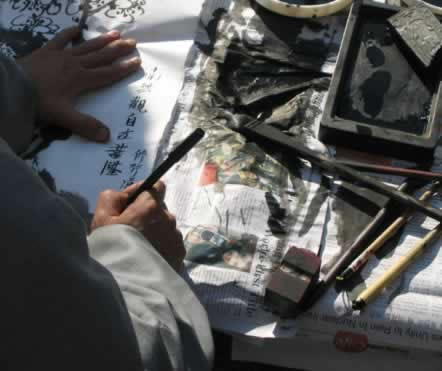
More than 1500 years ago, the notion of ch’i, however, was considered the most important quality in a painting by Hsieh Ho, of the fifth century, who put forward the Six Canons:
1. Infuse ch’i/yün to show life-movement;
2. Establish bone method in using the brush;
3. Respond to matter by creating form;
4. Distinguish objects by applying colors;
5. Arrange elements in appropriate positions;
6. Study earlier examples by copying them.
According to Wucius Wong’s “The Tao of Chinese Landscape Painting”, these are principles that are treasured. Classically, artist and art essayists have regarded these canons as the supreme guidelines in painting. The canons determine various goals of artistic pursuit, with the first canon having paramount importance. There have been numerous interpretations of this canon, but put in simple words
“it means that a painting should breathe with life.”
In varying interpretations, ch’i and yün either represent separate concepts or stand as a single term. Ch’i , standing for breath, incorporates such meanings as spirit, energy, and force, all used in a cosmic sense. The Chinese character yün can mean organic harmony, concord, charm, resonance, or rhythm. When ch’i and yün function together as a single term, the term refers to the vital breath of harmony, incorporating the meanings of both characters.
The whole phrasing for the opening canon is: “A true work of art should express the rhythmic vitality of the breath of heaven”.
How, possibly, might this be linked to the notion of design, or identity, for application in any environment of communications? Esoteric yes, but relevant, surely. The point reaches to the context of “lustration”, the idea of capturing the spirit of an entity – which could be an enterprise, a product, a concept of expression. And really, it’s about finding the ch’i of an enterprise and team, the fire of the brand, what heat is there. When I work, I tend to consider the relationship with my clients as a kind of meditation.
Watch, lean in, listen, watch, learn and move.
Forward.
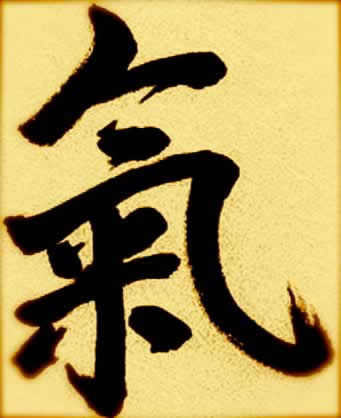
It’s a settling in, a contemplation into their world, and being in there, being absorbed in that reflection allows me, and the team at Girvin, to mindfully gather-in their sense of culture. That embrace draws me into their audience, their place of experience — and that brings me into proximity to make what we create for them “shine”.
More so, it’s a captivation of spirit, going back to the beginnings of the notation — it’s breathing-in, and exhalation of the character of the brand, the fire, the soul, the vitality that is critical to the nature of building resonance in community, in communications.
ENERGY
COUNTS
FOR
EVERYTHING.
Energy is the wave, it’s the push, it’s the engagement, it’s the spirit, it’s the rousing of community.
And the shining? That’s epiphany — the momentary glimmer of insight.
Etymologist Harper articulates:
epiphanes “manifest, conspicuous,” from epiphainein “to manifest, display, show off; come suddenly into view,” from epi “on, to” (see epi-) + phainein “to show” (from PIE root *bha- (1) “to shine”).
It’s the shining, and something we used to refer to at Procter&Gamble — shelf epiphany. The jump: the leap by a customer into a new insight about a brand. And the illustrative link?
illustration
c.1375, “a spiritual illumination,” from O.Fr. illustration, from L. illustrationem (nom. illustratio) “vivid representation” (in writing), lit. “an enlightening,” from illustrare “light up, embellish, distinguish,” from in- “in” + lustrare “make bright, illuminate.”
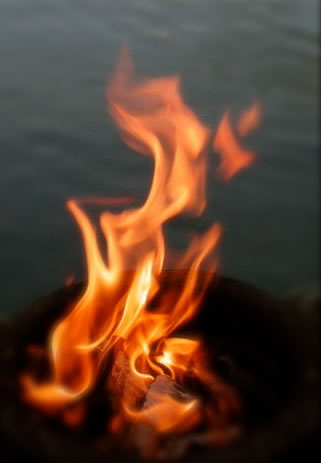
What could be more, to the nature of identity,
than to create that bridge from heart, to fire,
to lighting the message from the inside,
to the outside, in moving forward in change?
It’s fluency, it is flow,
it is energy catalyzed.
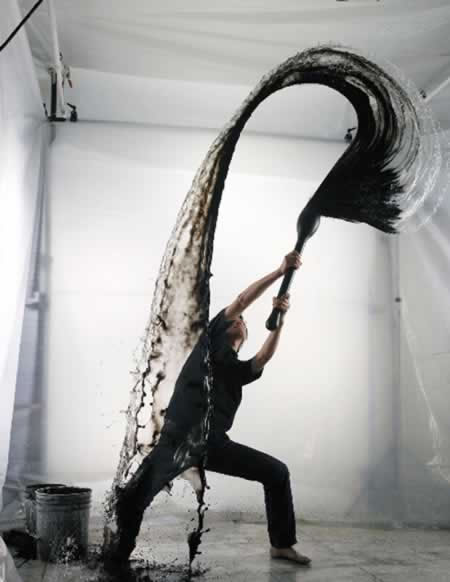
Image credit: Shinichi Maruyama
You flow where you go.
tim | GIRVIN | queen anne
Strategic Magic Studios
—-
BRANDSPIRIT
E x p l o r i n g f i r e b r a n d s:
References:
Google book: The Way of the Brush
Scholarship:
http://www.jstor.org/pss/2049541
http://www.jstor.org/pss/426036
Wong, Wucius. The Tao of Chinese Landscape Painting, Principles & Methods. New York: Design Press. 1991.
GIRVIN ch’i references:
Calligraphy
Painting books
Journals:
Girvin and Ink
Meeting a Zen master
Etymology:
epiphany and the shining
lustration